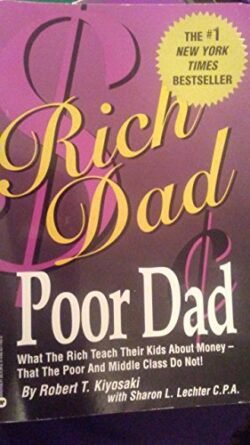“Rich Dad Poor Dad: What the Rich Teach Their Kids About Money-That the Poor and the Middle Class Do Not!” by Robert T. Kiyosaki is a groundbreaking book that challenges conventional views on money, investing, and employment. Through the contrasting philosophies of his two dads—one, his biological father (the “Poor Dad”), and the other, the father of his best friend (the “Rich Dad”)—Kiyosaki explores the concepts of financial education, wealth building, and the importance of financial independence. While the book doesn’t feature characters in a traditional sense, it personifies the Panama Canal as the central “character” in its historical narrative, detailing its conception, birth, and enduring legacy. The Panama Canal as the Central Character: The Panama Canal is presented not just as an engineering marvel but as a testament to human ingenuity, ambition, and perseverance. The narrative delves into the struggles encountered during its construction, including the battle against disease, the immense physical labor required, and the technological innovations employed. The canal’s story is interwoven with brief accounts of key figures involved in its creation, such as Ferdinand de Lesseps and Theodore Roosevelt, showcasing the human element behind this monumental project. Character Analysis Robert T. Kiyosaki: The narrative centers around Kiyosaki’s own experiences, using the contrasting beliefs and financial strategies of his “Poor Dad” and “Rich Dad” to illustrate broader financial principles. Kiyosaki portrays himself as someone who, through observing and learning from his “Rich Dad,” comes to challenge and reject the conventional financial wisdom taught by his well-educated but financially struggling “Poor Dad.” Poor Dad: Kiyosaki’s biological father, referred to as “Poor Dad,” embodies the traditional beliefs in education and hard work as the primary paths to financial success. However, despite his education and job security, Poor Dad’s adherence to conventional financial advice leaves him financially unstable. Rich Dad: Contrastingly, Kiyosaki’s “Rich Dad” is a savvy entrepreneur who teaches Kiyosaki the value of financial literacy, investing, and creating multiple streams of income. Rich Dad’s teachings emphasize acquiring assets over liabilities and learning how money can work for you, rather than working for money. Themes and Analysis Financial Education: A key theme is the importance of financial education, highlighting how traditional schooling often fails to teach practical financial skills. Assets vs. Liabilities: Kiyosaki introduces the fundamental financial concept of distinguishing between assets and liabilities, advocating for investment in assets that generate income. Mindset and Wealth Building: The book stresses the role of mindset in achieving financial success, arguing that how one thinks about money significantly impacts one’s financial destiny. “Rich Dad Poor Dad” is not just a financial advice book; it’s a call to rethink how one approaches money, investing, and work. By sharing the lessons learned from his “Rich Dad,” Kiyosaki provides readers with the tools to build wealth and achieve financial independence. The contrasting approaches to money and investing offered by his two dads serve as a powerful illustration of the book’s core message: that financial literacy and a proactive approach to wealth building are key to escaping the “rat race” and achieving financial success. This book remains a seminal work in the field of personal finance, inspiring readers to take control of their financial futures. If the summary caught your interest, Consider reading the full book on AbeBooks. Explore this book on AbeBooks

